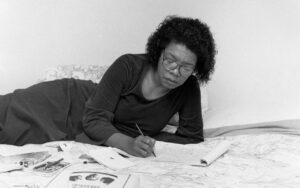Analysis of the “Still I Rise” Poem
For an overview of the annotations and an explanation for the rationale behind the annotations read below.

Maya Angelou was an African American civil rights activist who used poetry and other works of art, such as film, to contribute to the movement. Her work, still apparent and relevant today, was written about the black community and black womanhood. Proud of her identity and hopeful at the time for a change in rights for her race, Angelou found great success with her poetry collections. To further clarify and break down the strong message and stylistic components of her poem, digital annotations and page notes were added.
The intended audience for this project was high school students, so basic annotations on vocabulary, stylistic components, and interpretations were used to enhance the poem. The hope is that the viewer can walk away after viewing the annotations and page notes and be able to understand the poem in its entirety, including the overall meaning – as well as the meaning found within each stanza – and the ways in which Angelou was able to convey this meaning. The main question that I was aiming to answer with this project revolved around the poem’s connection to history, Angelou’s poetic style, and the overall meaning of the poem. Essentially, I wanted to dissect the poem and understand the context of each line in relation to the meaning of the poem and how that connected to the lives of African Americans at the time – exploring the civil rights movement further.
Generally about self-respect and confidence, the poem insists that no matter the intensity of the oppression Angelou intends to rise to the occasion – portraying that nothing, not even her skin color, can inhibit her – and encouraging others to adopt the same attitude. Angelou’s writing uses a direct and conversational voice, allowing the reader to interact with the text in a unique way as they feel like they are communicating directly with the speaker. Her style combines both Standard English (the formal and informal commonly accepted form of English at the time) and African American English (which was a dialect of English that was spoken in the African American community). A page note was created to cover the general mechanics of the poem, such as the information detailed in this paragraph as well as the genre, rhyme, perspective, conflict, etc. The goal with the page notes was to describe important and relevant details about the poem that were not specifically written in the lines of the poem. One page note was written on the mechanics of the poem and another was written to give background on the historical context of the poem.

Not only did I unpack her literary style, I also was able to learn more about her life as an African American growing up during this Reconstruction and civil rights era in America and the historical context of the poem. Annotations were made on lines in the poem where Angelou referenced the past. I also attached links to let the audience explore more about the movement and the time period in which the poem was published. This page note covers African American experiences with the Great Migration, Great Depression, World War Two, and the civil rights movement.
While sharing her stories and secrets and simultaneously tying in her culture, she implements an abundance of literary elements, like similes, metaphors, symbols, juxtaposition, repetition, understatements, and alliteration. Annotations were made on each of these elements found in her poem “Still I Rise.” It is expected that the audience knows what each of the elements is, so my annotations included an interpretation of the literary element and a connection of how it related to the overall meaning of the poem. Each of these literary elements has a persuasive role in developing the meaning. While the theme of mild protesting is incorporated into this text, she publicizes the suffering and hardships experienced by her race, while intertwining humor to keep hope at the surface of her works.
Hyperlinks to definitions were added to certain words which have unclear or ambiguous meanings within the context of the poem. The annotations and page notes are suited for this specific project and audience because they cover the basic understanding of the poem. They break down her poetic style, the historical context, and the lines of the poem.